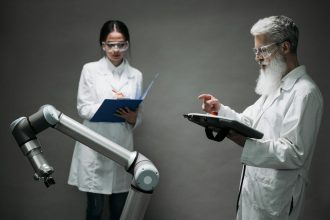Neural Networks: 7 Breakthroughs Shaping Tomorrow’s AI?
For decades, the concept of machines mimicking human thought has captivated researchers and innovators alike. Today, this vision is rapidly becoming a reality, largely powered by the incredible advancements in neural networks. These sophisticated computational systems are the backbone of modern artificial intelligence, driving everything from personalized recommendations to self-driving cars. But what exactly are they, and how are they transforming our world?
Understanding the Core of Neural Networks
At its heart, a neural network is a series of algorithms that endeavors to recognize underlying relationships in a set of data through a process that mimics the way the human brain operates. It learns from vast amounts of data, identifying patterns and making predictions or decisions without explicit programming for every task.
From Biological Inspiration to Digital Reality
The initial idea for these networks emerged from studying the biological structure of the brain, particularly the interconnected neurons. Early pioneers envisioned artificial systems that could process information in a similar, parallel fashion. This foundational concept laid the groundwork for decades of research and development.
While the earliest models faced significant computational hurdles and limitations in processing complex data, the persistent vision for self-learning systems never faded. These early explorations, though rudimentary by today’s standards, proved the potential for machines to extend their capabilities beyond simple rule-based logic.
The Evolution of Artificial Neural Networks
The journey of artificial neural networks has been marked by periods of intense innovation and quiet development. Initially, simple perceptrons demonstrated basic learning capabilities, but struggled with more intricate problems. The introduction of backpropagation in the 1980s provided a crucial method for training multi-layered networks, allowing them to learn from errors and refine their predictions.
This breakthrough, coupled with increasing computational power and the availability of massive datasets, catalyzed the “deep learning” revolution. Deep neural networks, characterized by their numerous hidden layers, are now capable of extracting highly abstract features from data, leading to unprecedented performance in areas like image recognition and natural language processing.
Modern Applications: Where Neural Networks Shine
Today, neural networks are not just theoretical constructs; they are integral to countless real-world applications. Their ability to learn from complex data has made them indispensable across various sectors. For instance, in healthcare, they assist in diagnosing diseases by analyzing medical images with remarkable accuracy. In finance, they detect fraudulent transactions by identifying unusual patterns in spending behavior.
Revolutionizing Industries with Deep Learning
The impact of deep learning, a subset of neural networks, is particularly profound. Here are just a few examples of how they are making a difference:
- Image and Speech Recognition: Powering facial recognition in security systems and voice assistants like Siri or Alexa.
- Natural Language Processing (NLP): Enabling machine translation, sentiment analysis, and intelligent chatbots.
- Personalized Recommendations: Driving content suggestions on streaming services and e-commerce platforms.
- Autonomous Systems: Crucial for the perception and decision-making capabilities of self-driving vehicles and robots.
- Drug Discovery: Accelerating the identification of potential new drug compounds and predicting their efficacy.
These applications underscore the versatility and transformative potential of well-trained neural networks in solving complex, real-world problems.
The Future Landscape of Neural Networks
The trajectory of neural networks suggests an even more impactful future. Researchers are continually pushing boundaries, exploring new architectures and learning paradigms. We can anticipate more sophisticated AI models that require less data to train, are more interpretable, and can generalize across diverse tasks more effectively. Furthermore, advancements in neuromorphic computing promise hardware specifically designed to run these networks with greater efficiency.
Ethical Considerations and Responsible AI Development
As these technologies become more pervasive, addressing ethical considerations becomes paramount. Ensuring fairness, transparency, and accountability in AI systems built with neural networks is crucial. Developers and policymakers are working to establish guidelines that promote responsible AI development, mitigating potential biases and unintended consequences. This includes focusing on explainable AI (XAI) to understand why a network makes certain decisions.
The ongoing development also includes efforts to make these powerful tools more accessible. Open-source frameworks and cloud-based AI services are democratizing access, allowing a broader range of innovators to experiment and deploy their own neural network solutions.
Key areas of future development include:
- Explainable AI (XAI): Making complex models more transparent.
- Federated Learning: Training models on decentralized data without compromising privacy.
- Reinforcement Learning: Enabling AI to learn through trial and error in dynamic environments.
- Quantum Neural Networks: Exploring the potential of quantum computing for AI.
Why Mastering Neural Networks Matters Now
The profound influence of neural networks on technology and society is undeniable. From revolutionizing scientific research to enhancing everyday conveniences, their impact is only set to grow. Understanding these systems is no longer just for specialized researchers; it’s becoming a foundational skill for anyone looking to navigate or innovate in the modern digital landscape.
They represent a paradigm shift in how we approach problem-solving with computers, moving from explicit instructions to adaptive learning. Embracing this technology means unlocking new possibilities and preparing for a future increasingly shaped by intelligent automation and predictive analytics.
For further reading on the foundational concepts of artificial intelligence, you might explore resources from IBM’s comprehensive guide to AI. To delve deeper into the mathematical underpinnings of machine learning, including neural networks, Google’s Machine Learning Crash Course offers excellent insights.
In conclusion, neural networks stand as a testament to human ingenuity, bridging the gap between biological inspiration and advanced computational power. They are not merely algorithms but the engines driving the next era of artificial intelligence, promising to reshape industries, solve complex challenges, and redefine our interaction with technology. The journey of these fascinating systems is far from over, and their continued evolution will undoubtedly bring about even more astonishing breakthroughs.
Ready to explore how neural networks can transform your projects? Start learning today!
Unlock the power of neural networks! Discover how these AI marvels are revolutionizing technology, from deep learning to predictive analytics. Explore their impact today.









